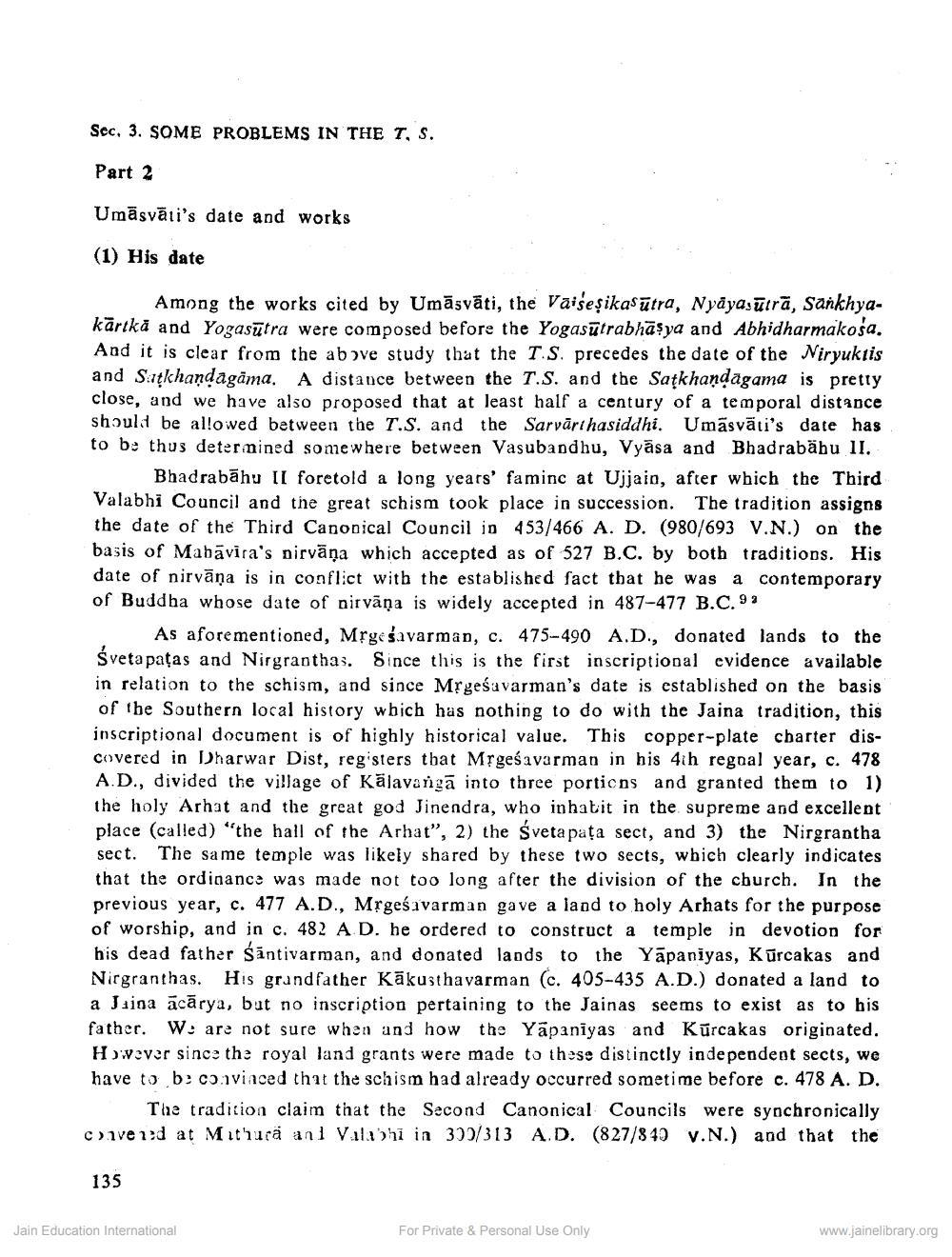________________
Sec, 3. SOME PROBLEMS IN THE T, S.
Part 2
Umāsvāli's date and works
(1) His date
Among the works cited by Umāsvāti, the Vaiseșikasūtra, Nyāyasūtrā, Sankhyakārtkā and Yogasūtra were composed before the Yogasūtrabhāşya and Abhidharmakosa. And it is clear from the above study that the T.S. precedes the date of the Niryuktis and Satkhandagama. A distance between the T.S. and the Satkhandagama is pretty close, and we have also proposed that at least half a century of a temporal distance should be allowed between the T.S. and the Sarvāri hasiddhi. Umāsvāti's date has to be thus deter nined somewhere between Vasubandhu, Vyāsa and Bhadrababu II.
Bhadrabāhu Il foretold a long years' faminc at Ujjain, after which the Third Valabhi Council and the great schism took place in succession. The tradition assigns the date of the Third Canonical Council in 453/466 A. D. (980/693 V.N.) on the basis of Mabāvira's nirvāṇa which accepted as of 527 B.C. by both traditions. His date of nirvana is in conflict with the established fact that he was a contemporary of Buddha whose date of birvāņa is widely accepted in 487-477 B.C.93
As aforementioned, Mrgesavarman, c. 475-490 A.D., donated lands to the Śveta patas and Nirgranthas. Since this is the first inscriptional evidence available in relation to the schism, and since Mrgesavarman's date is established on the basis of the Southern local history which has nothing to do with the Jaina tradition, this inscriptional document is of highly historical value. This copper-plate charter discovered in Dharwar Dist, registers that Mrgesavarman in his 4ih regoal year, c. 478 A.D., divided the village of Kālavargā into three porticns and granted them to 1) the holy Arhat and the great god Jinendra, who inhabit in the supreme and excellent place (called) “the hall of the Arhat", 2) the “veta pața sect, and 3) the Nirgrantha sect. The same temple was likely shared by these two sects, which clearly indicates that the ordinance was made not too long after the division of the church. In the previous year, c. 477 A.D., Mrgeśavarman gave a land to holy Arhats for the purpose of worship, and in c. 482 A D. he ordered to construct a temple in devotion for his dead father Säntivarman, and donated lands to the Yāpaniyas, Kūrcakas and Nirgranthas. His grandfather Kākusthavarman (c. 405-435 A.D.) donated a land to a Jaina ācārya, but no inscription pertaining to the Jainas seems to exist as to his father. W. are not sure when and how the Yāpaniyas and Kūrcakas originated. However since the royal land grants were made to these distinctly independent sects, we have to be conviaced that the schism had already occurred sometime before c. 478 A. D.
The tradition claim that the Second Canonical Councils were synchronically cnved at Mithura ani Valahi in 390/313 A.D. (827/840 v.N.) and that the
135
Jain Education International
For Private & Personal Use Only
www.jainelibrary.org




